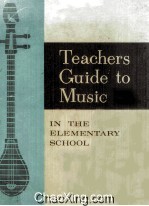
- 作 者:
- 出 版 社:California State Department Of Education Sacramento
- 出版年份:1963
- ISBN:
- 标注页数:149 页
- PDF页数:159 页
请阅读订购服务说明与试读!
订购服务说明
1、本站所有的书默认都是PDF格式,该格式图书只能阅读和打印,不能再次编辑。
2、除分上下册或者多册的情况下,一般PDF页数一定要大于标注页数才建议下单购买。【本资源159 ≥149页】
图书下载及付费说明
1、所有的电子图书为PDF格式,支持电脑、手机、平板等各类电子设备阅读;可以任意拷贝文件到不同的阅读设备里进行阅读。
2、电子图书在提交订单后一般半小时内处理完成,最晚48小时内处理完成。(非工作日购买会延迟)
3、所有的电子图书都是原书直接扫描方式制作而成。
A MESSAGE TO THE TEACHER 1
BASIC CONCEPTS 2
The Creative Approach 2
Music Listening 2
Development of Skills and Music Reading 2
Stimulation of Musical Growth 2
Choice of Music 3
The Unique Value of Music in the Curriculum 3
Time Allotment 3
A Balanced Program 3
Music Throughout the School Day 3
CALIFORNIA STATE SERIES:TEXTBOOKS IN MUSIC 4
OTHER BOOKS AND RECORDED MUSIC USED IN THE EXAMPLES IN THIS GUIDE 5
PART ONE:MUSIC EXPERIENCES 7
KINDERGARTEN AND GRADES ONE AND TWO 8
FIRST APPROACH-Beginning with Rhythmic Activity Natural to Children 9
SECOND APPROACH-Beginning with Singing 15
THIRD APPROACH-Beginning with Playing Instruments 21
GRADES THREE AND FOUR 27
FIRST APPROACH-Beginning with an Instrument 28
SECOND APPROACH-Beginning with Listening to a Recorded Orchestral Composition 31
THIRD APPROACH-Beginning with Singing 35
FOURTH APPROACH-Beginning with Listening to a Recorded Orchestral Composition 39
GRADES FIVE AND SIX 43
FIRST APPROACH-Beginning with Singing 44
SECOND APPROACH-Beginning with Listening 49
THIRD APPROACH-Beginning with a Rhythmic Experience 54
GRADES SEVEN AND EIGHT 61
FIRST APPROACH-Beginning with Rhythmic Activities 62
SECOND APPROACH-Beginning with Singing 66
THIRD APPROACH-Beginning with Listening 69
FOURTH APPROACH-Instrumental Experiences That Begin with Singing 72
MULTIGRADED CLASSES 77
FIRST APPROACH-Beginning with Singing 78
SECOND APPROACH-Beginning with Listening to a Recorded Song 81
THIRD APPROACH-Beginning with Listening to a Recorded Orchestral Composition 82
FOURTH APPROACH-Beginning with Listening to a Recorded Orchestral Composition 85
PART TWO:PRINCIPLES AND PROCEDURES 87
PRINCIPLES AND PROCEDURES FOR SINGING ACTIVITIES 88
Finding the Tonality of a Song 88
Directing Singing 89
Teaching a Song 90
Developing Part Singing 92
Guiding Vocal Development 95
Dealing with the Changing Voice 97
PRINCIPLES AND PROCEDURES FOR RHYTHMIC ACTIVITIES 101
Types of Activity 101
Rhythmic Development at Various Growth Levels 102
Management of the Rhythmic Activities 102
Variety in Procedures 103
PRINCIPLES AND PROCEDURES FOR LISTENING ACTIVITIES 107
Selecting the Materials 107
Presenting Program Music with Obvious Descriptive Implications 107
Presenting Program Music with Less Obvious Descriptive Implications 109
Presenting Absolute Music 110
Presenting Two Types of Listening Lessons 112
PRINCIPLES AND PROCEDURES FOR INSTRUMENTAL ACTIVITIES 117
The Rhythm Instruments 117
Tuned Bell Instruments 123
Flute-type Instruments 125
The Autoharp 127
Orchestral Instruments 128
THE EVALUATION OF A PROGRAM IN MUSIC EDUCATION 131
Evidence of Pupil Growth 131
Appraisal of Teacher-Pupil Activities 131
Appraisal of Teacher Activities 132
Appraisal of Physical Activities 132
Appraisal of the Use of School and Community Resources 132
APPENDIX 133
APPENDIX A.REPERTOIRE OF FAMILIAR SONGS FOR GROUP AND ASSEMBLY SINGING 134
APPENDIX B.MUSICAL TERMS AND SYMBOLS 137
Pitch:Staff,Clefs,and Leger Lines 137
Tonal Relationships 138
Chords 140
Essentials in Rhythm 142
Melody:Characteristics and Notation 144
Other Musical Signs 146
APPENDIX C.EQUIPMENT AND SUPPLIES FOR CLASSROOM AND SCHOOL USE 147
Books 147
Audio-visual Equipment and Materials 147
Instruments 148
Recordings 149
Standard Classroom Supplies and Furnishings 149
